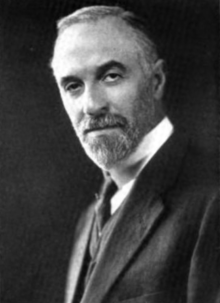
Summary
Julius Oscar Stieglitz (May 26, 1867 – January 10, 1937) was an American chemist of German Jewish origin. He was a teacher and organic chemist with a major interest in pharmaceutical and medicinal chemistry. He is known for the Stieglitz rearrangement, a rearrangement reaction in organic chemistry which commonly involves the formation of imines from hydroxylamines through a carbon to nitrogen shift, comparable to the key step of a Beckmann rearrangement.[1][2][3]
Julius Stieglitz | |
|---|---|
 | |
| Born | May 26, 1867 Hoboken, New Jersey, United States |
| Died | January 10, 1937 (aged 69) Chicago, Illinois |
| Alma mater | University of Berlin |
| Known for | Stieglitz rearrangement |
| Awards | Willard Gibbs Award (1923) |
| Scientific career | |
| Institutions | University of Göttingen, Clark University, University of Chicago, University of Marburg |
| Doctoral advisor | Ferdinand Tiemann |
During the early stages of his career, he worked for Parke, Davis & Co. in Detroit as a toxicologist. After attending private and public schools in New York during his early years, both he and his twin brother Leopold were sent to Germany for their higher education. He went to the Gymnasium in Germany and studied at the University of Berlin, where he received his PhD in chemistry in 1889 with Ferdinand Tiemann. Following a short period of study with Victor Meyer at Göttingen, he returned to the U.S. in 1890. In 1892 Stieglitz started working at the University of Chicago, where his whole career until his retirement took place.
Julius and his twin brother Leopold were born in Hoboken, New Jersey on May 26, 1867, to Edward Stieglitz (1833–1909) and Hedwig Ann Werner (1845–1922). His elder brother was the photographer Alfred Stieglitz. He married Anna Stieffel on August 28, 1891.
He began his career at the University of Chicago in 1892 as an unpaid docent, lecturing without salary and sustaining himself from student donations. In 1893 he was appointed assistant professor, and moved up through the ranks to become professor of chemistry in 1905. He served as department chair from 1915 to 1933.
In 1933, he was named professor emeritus but continued to teach and serve as board chair of the American Chemical Society. Dr. Stieglitz was very active in ACS, serving as the Chicago Section Chair in 1904, and ACS President in 1917. In 1911, he was elected to the National Academy of Sciences.[4] He was elected to the American Academy of Arts and Sciences in 1914 and the American Philosophical Society in 1919.[5][6] Stieglitz helped to establish the Willard Gibbs Medal, and received the Gibbs Medal himself in 1923. He received honorary doctorates from Clark University (D.Sc.) and the University of Pittsburgh (Ph.D.).
He died in Chicago on January 10, 1937.[7]
Stieglitz Lecture edit
The Stieglitz Lecture was established using funds dedicated in his memorial legacy in 1940. The lecture was presented alternatively by the University of Chicago Chemistry department and the Chicago Section of the ACS in consecutive years until 1994. There was a pause in presentation from 1994 until 1999 until the funds built up to a level where they were sufficient to support a stipend of $1,000 plus expenses for each year.
References edit
- ^ Julius Stieglitz, Paul Nicholas Leech (1914). "The molecular Rearrangement of Triarylmethyl-Hydroxylamines and the Beckmann Rearrangement of Ketoximes". Journal of the American Chemical Society. 36 (2): 272–301. doi:10.1021/ja02179a008.
- ^ Bert Allen Stagner (1914). "The molecular Rearrangement of Triarylmethyl-Hydroxylamines". Journal of the American Chemical Society. 36 (2): 2069–2081. doi:10.1021/ja02267a018.
- ^ Wang, Zerong (2010). Comprehensive organic name reactions and reagents. John Wiley & Sons, Inc. pp. 288–295. ISBN 9780471704508.
- ^ "Julius Stieglitz". www.nasonline.org. Retrieved September 27, 2023.
- ^ "Julius Oscar Stieglitz". American Academy of Arts & Sciences. February 10, 2023. Retrieved September 27, 2023.
- ^ "APS Member History". search.amphilsoc.org. Retrieved September 27, 2023.
- ^ "Julius Stieglitz Dies; Noted U. of Chicago Chemist". Chicago Tribune. January 11, 1937. p. 14. Retrieved December 20, 2020 – via Newspapers.com.
- William Albert Noyes (1937), Biographical Memoir of Julius Stieglitz (PDF), National Academy of Science
- Jim Shoffner (2012), Dr. Julius Stieglitz and the Stieglitz Lectures (PDF), Chicago Section of the American Chemical Society, p. 4
Further reading edit
- Stieglitz, J (1919), "Chemistry and Medicine: A Tribute to the Memory of John Harper Long", Science, vol. 49, no. 1254 (published January 10, 1919), pp. 31–38, Bibcode:1919Sci....49...31S, doi:10.1126/science.49.1254.31, PMID 17735880
- Stieglitz, J (1917), "The Outlook in Chemistry in the United States", Science, vol. 46, no. 1188 (published October 5, 1917), pp. 321–333, Bibcode:1917Sci....46..321S, doi:10.1126/science.46.1188.321, PMID 17816438
- Stieglitz, J (1908), "The Applications of Physical Chemistry to Organic Chemistry", Science, vol. 27, no. 698 (published May 15, 1908), pp. 768–775, Bibcode:1908Sci....27..768S, doi:10.1126/science.27.698.768, PMID 17791043
- Stieglitz, J (1907), "Chemical Research in American Universities", Science, vol. 26, no. 673 (published November 22, 1907), pp. 699–703, Bibcode:1907Sci....26..699S, doi:10.1126/science.26.673.699, PMID 17738116
External links edit
- Works by Julius Stieglitz at Project Gutenberg
- Works by or about Julius Stieglitz at Internet Archive


